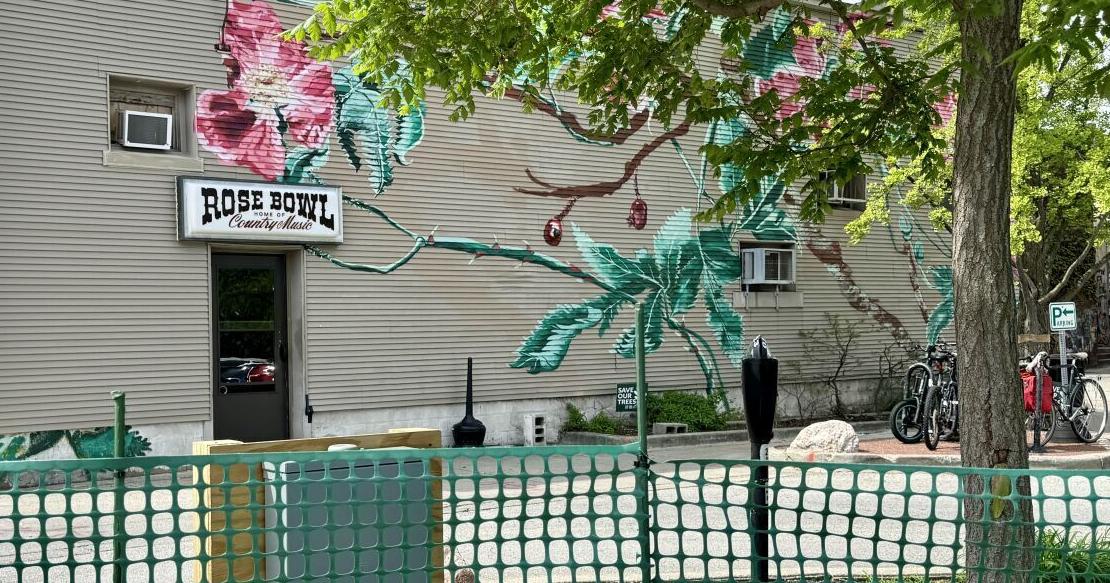Drop in a question of your very own BY CLICKING HERE or by emailing Kathy Reiser at mailbag@news-gazette.com.
Sign up for our new Kathy’s Mailbag newsletter here
A fun mix of questions this week: Is the Rose Bowl’s outdoor concert venue coming back this year? Could lumber from the Mahomet Hen House’s recent demolition have been saved and re-used? And do any local ice cream shops make “cho-chos,” a much-loved treat they used to sell at Honk’s Standard Station in Sidney? All this and more in this week’s Mailbag.


This complex of buildings at 208 W. Griggs Street in Urbana is the home of Jim Creason’s 25 O’Clock Brewing Company and formerly housed the Best of Africa Food Store and Mama’s African Kitchen. The striking Africa-themed murals on the front of the building are by Glen Davies, according to the owner of the property, Mike Hosier.
The current and recent uses of the former Leavitt Manufacturing Company buildings couldn’t be more different from the structures’ original purpose.
According to a 2014 Preservation and Conservation Association newsletter, Abram Snedeker established the Enterprise Foundry at the northeast corner of Grove and Locust Streets in Urbana in 1872. “In the early 20th century, the foundry was remodeled by Urbana architect Joseph William Royer for businessman H.W. Leavitt of Tuscola, Illinois. Leavitt turned the modest Urbana foundry into a worldwide operation.”
Leavitt made railroad engine and roadway castings, as well as structural iron and steel. The company shipped finished goods – including sickle lawn mowers — to Scotland, Cuba, Canada, Haiti, South America, New Zealand, Australia and South Africa and the Philippines. “In addition to mowers, Leavitt produced cattle leaders, self-cleaning rakes, corn pickers, gasoline engines, fertilizer distributors, sash weights, ventilating grates, fire escapes, and window cleaners — and also repaired machinery.”
One of their most popular products? The Leavitt bull dehorner. (I checked, and you can buy one on eBay.)
Leavitt Manufacturing expanded into the sporting goods business, “producing baseball bats, golf hardwood flag poles, javelins and discus according to the specifications of Harry Gill, UI track coach, and eventually had an entire building at the plant dedicated to the production of these products.”
One of Leavitt’s most successful products was the collapsible “Knock-Down” portable bleacher designed for temporary use. Demand for it was so great that the firm was renamed the Leavitt Bleacher Company.
In the 1970s, the Bailey & Himes Sporting Goods Company Warehouse occupied much of the space, followed by the Eastern Illinois Food Bank in the 1980s, ’90s and early 2000s. Carle Printing Services moved next. After Mike Hosier bought the property, it served mostly as a warehouse for Habitat for Humanity’s retail operation, with Best of Africa expanding there once the Habitat warehouse relocated.
The PACA article said the complex is the last remaining late 19th/early 20th century industrial complex in Urbana along the former Danville-Urbana-Bloomington-Pekin Railroad, the first railroad to pass through Urbana upon completion in 1869.


“With nicer weather, I was curious if the Rose Bowl Tavern’s patio will be opening this spring. I had heard they’d run into some issues with city.”
The Home of Country Music’s outdoor venue is set to open as of today, according to employee Holly Curia, who was helping crews install a temporary fence there on Wednesday of this week.
The so-called patio is a large portion of the City of Urbana parking lot located immediately north of the bar. “We now lease the lot from the city, May through October. It’s a three-year lease. We’re looking to keep this going for a while, so it’s going to be a sure-fire thing for people to rely on for at least a few more years,” Curia said.
As for the issues the reader mentioned in the question…? She said “we’re actually on really good terms with the city now.” When the Rose Bowl floated the idea of using the outdoor area on city property, the city was in favor but there was some initial resistance from a few neighboring businesses.
Curia said things have been “smoothed over” with nearby businesses, some of which have benefited from additional food sales to hungry music fans at the “BYO food” bar and music venue.

Dave Norvel of Lee Farms Excavating sweeps debris into the basement as the Hen House building in Mahomet is taken down Thursday.
“Looked like a lot of good, used lumber went to waste when the Mahomet Hen House was demolished and the debris trucked away a few weeks ago. Is there a market for used lumber?”
Preservation and Conservation Association Executive Director Tom Garza says there is demand for some types of used lumber — but the effort involved in reclaiming it usually is prohibitive. “When PACA salvages older buildings, we generally only remove the surface trim — doors and window casing, baseboards, etc. One reason for this is that we are rarely the last people who are going to be in the building, and so it needs to continue to be structurally sound after we leave it.
“And also, even in situations where this isn’t the case, there are many safety factors involved in removing structural timber since obviously these pieces are the very fabric of the structure itself. They hold the building up and keep it together. A fair amount of knowledge about how buildings are put together is required to take a place apart safely.”
The nails, screws and other fasteners that are in each piece of lumber pose another time-consuming challenge. Any metal must be removed before boards can be reused or repurposed.
Even if someone had the expertise to pick apart a building, liability and insurance concerns might make a property owner think twice about allowing it. “The places that I’ve heard of that do this kind of salvaging mostly focus on old barns and outbuildings since those are much simpler structures to take apart with fewer connections overall. Heavy equipment or a small army of knowledgeable helpers is required since you will be taking down entire walls and the roof structure, etc.,” Garza said. “All that being said, it can be done – and the quality of the lumber you can acquire this way is usually far superior to anything you can go buy at the lumberyard today. But you’re going to really work for it, and unless you have a great deal of free time and free help, it’s not going to be cost-effective.”



“Crews seem to be making good progress on the ‘big dig’ on northbound Neil Street, north of Springfield Avenue. What, exactly, have they been doing there? And when will they finish the project?”
It’s all part of the sanitary sewer expansion for the South Downtown Sanitary Sewer Project, according to Champaign Public Works’ Kris Koester. Crews have been making such good progress, in fact, that the area that was under construction on northbound Neil Street has reopened in recent days.
The work continues with a few more closures and excavation projects: The easternmost lane of Randolph Street at the intersection of White Street and Randolph Street, and the eastbound lane of White Street between State and Randolph Streets.
The White Street closure “will block northbound traffic on Randolph Street from continuing north of the White Street/Randolph Street intersection,” Koester said. “Northbound Randolph Street traffic will detour west onto White Street at the closure.”

“Is there anyplace in the area where they sell an ice cream treat called a ‘cho-cho’? It was a malt flavor, and a favorite of many back in the 1950s when they were available at Honk’s Standard Station in Sidney.”
What a fun question! I did a little research online, and it seems cho-chos were made by small, regional dairies in some parts of the U.S. during the 1940s and later. They are still a local favorite in Allentown and Reading, Pennsylvania and a few other places. Tucker’s Ice Cream shop in Alameda, Cal., describes the cho-cho — a bit of “mid-century Americana” — on its website: “This old fashion frozen treat is malted chocolate formed in a paper cup with a popsicle stick coming up from (the) top.
“Pro Tip: the trick to properly eating a cho-cho requires you to place the cup between both your hands, rub the outside of the cup between your palms for 5-7 seconds. This will loosen up the malted treat, allowing you to pull it out (by) the popsicle stick. Now the cho-cho resembles a popsicle and is ready to eat, and when you need to take a break you can place it back in the cup so it doesn’t drip or melt on you.”
We reached out to five local ice cream and frozen-treat shops to see if any of them carry cho-chos, and two have gotten back to us. Sidney Dairy Barn co-owner Ella Beal said “I had never heard of cho-chos, but so fun to learn about them.” Even so, she said they are not something Sidney Dairy Barn currently sells and “most likely won’t in the future.”
No cho-chos at Jarling’s Custard Cup in Champaign, either, according to manager Ashlee Rhodes. “While we don’t offer cho-cho’s, we do have malt powder that we make malted drinks, sundaes, snowstorms and other treats with.”

SHORES
“I like taking my dogs out for walks in the woods. With cicadas arriving soon, is it harmful if the dogs eat them?”
The expected abundance of cicadas later this spring and summer should not pose a significant risk to our local pet population, said Dr. Canaan Shores, DVM, head of the urgent and convenient care service at the University of Illinois Veterinary Teaching Hospital.

“Thankfully, these insects do not bite or sting, nor do we believe they carry any diseases that can be transmitted to dogs or cats. Most pets are likely to avoid them.
“However, if a pet does ingest cicadas, there are unlikely to be significant effects other than mild GI upset: drooling, reduced appetite, possible vomiting or diarrhea. For a pet that is experiencing these symptoms, the primary care veterinarian should be contacted for further recommendations.”
Shores said it’s always possible that some pets might try to eat large numbers of cicadas. “If a pet owner is concerned their pet may do this, they should take their pet outside on a leash so they can be carefully monitored.”
While cicadas may damage some young trees and woody shrubs, the USEPA website says “pesticides are generally ineffective in keeping cicadas away. So many cicadas emerge at once that more will inevitably move in. Spraying also doesn’t make sense because cicadas are generally harmless.”
The UI Vet School’s Dr. Stephany Lewis, DVM, said “we do not support the use of pesticides, as they can have unintended effects on wildlife. They can also kill the insects that our native wildlife rely on for food.”
“I see a lot of heavy-equipment activity at the SE corner of Main and Goodwin in Urbana. Is the UI about to build something there?”
“That location is being used as an additional laydown area for the Illini Hall replacement and Altgeld Hall renovation project,” said Steve Breitwieser, spokesperson for UI Facilities & Services. A laydown area is a secure spot where equipment, materials and other necessities are kept until they are needed for a construction project.
According to the UI College of Liberal Arts & Sciences website, the new Illini Hall “will be home to a new data science center as part of the Champaign-Urbana hub of the Illinois Innovation Network. The network will consist of various hubs across the state including the Discovery Partners Institute.”
Across Wright Street, Altgeld Hall – the campus’ original 1897 Library Building – is being modernized and restored. “Current plans include the restoration of mosaics, murals and woodwork in Altgeld Hall’s magnificent library,” the LAS website said.
An F&S webpage about the project says accessibility is a key goal of the Altgeld renovations. “Five separate Altgeld Hall renovation projects have been completed over time, and as a result, the building has numerous distinct levels connected by stairs or ramps. This project will improve accessibility by providing access to all building areas and minimizing the number of separate elevations.”

“Last week’s Mailbag question about vehicles with no front license plate prompts me to ask: How does the absence of a front plate affect the ability of ALPRs to do their job?”
The reader is referring to Automated License Plate Readers that are in use in several area communities (other than Urbana).
Champaign County Sheriff Dustin Heuerman told us “not having a front license plate has the potential to limit their effectiveness, but I believe most agencies who utilize this technology recognize that not all vehicles are required to have a front license plate so position the ALPRs in such a way to not impact their effectiveness.”

“The buildings at the Main Line Station rest areas on I-57 north of Loda are both closed, with no access to the indoor restrooms. Why? And how long are the closures expected to last?”
IDOT engineer Kensil Garnett checked with Trish Thompson, his counterpart who covers Iroquois County, and she said they were closed on April 2 because “the pumps for the sewage lagoons went down with bad bearings. They are currently with the vendor for repairs. The buildings will remain closed until the pumps are working again.” She did not have an estimated date for that.











